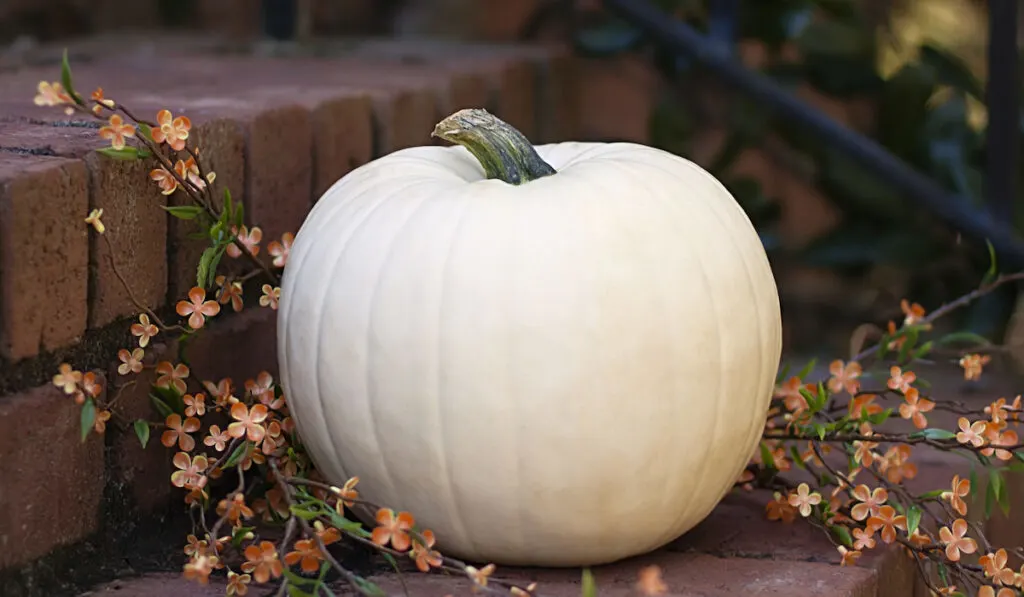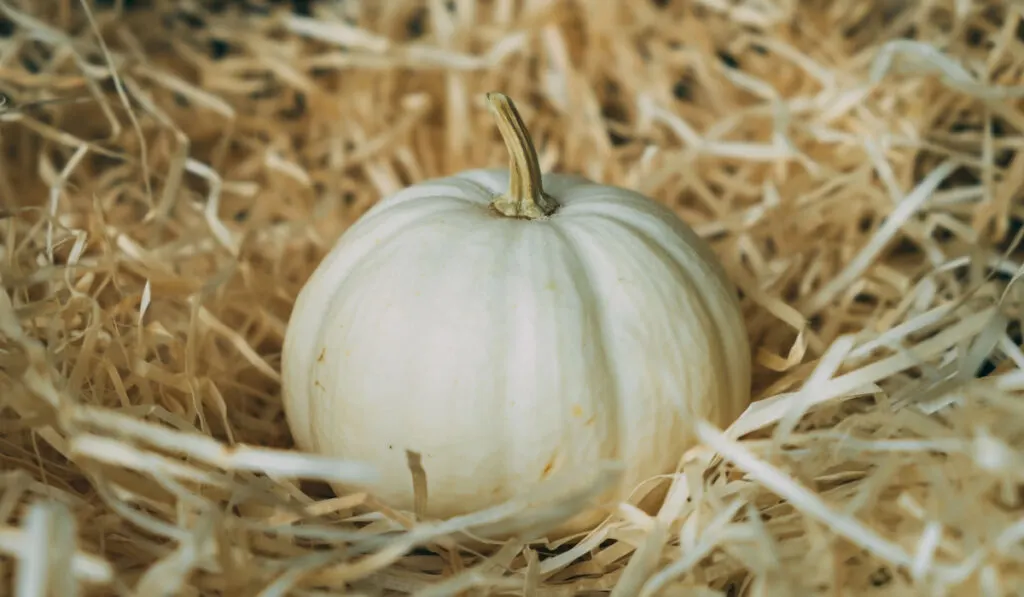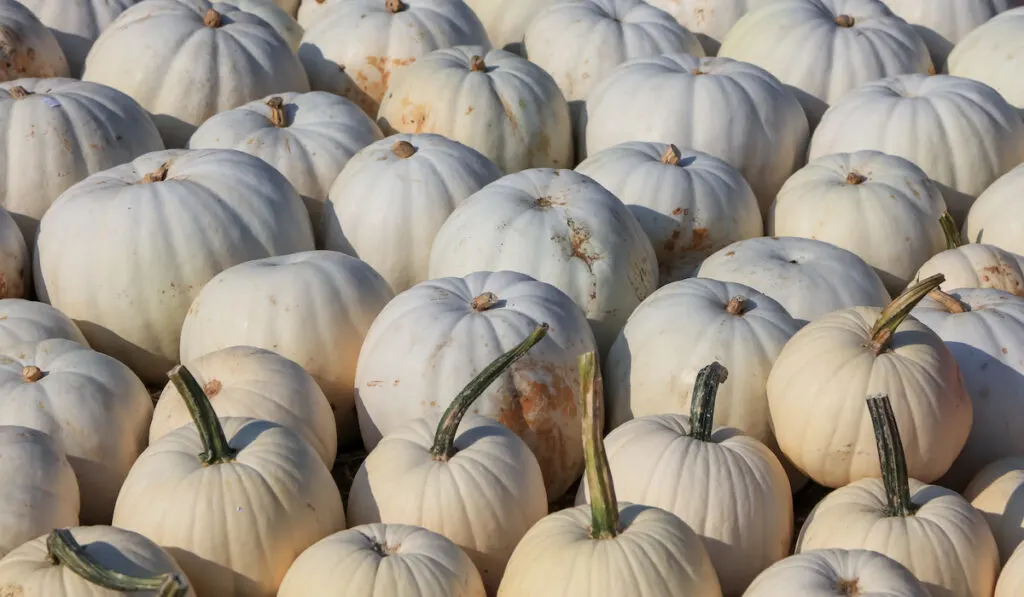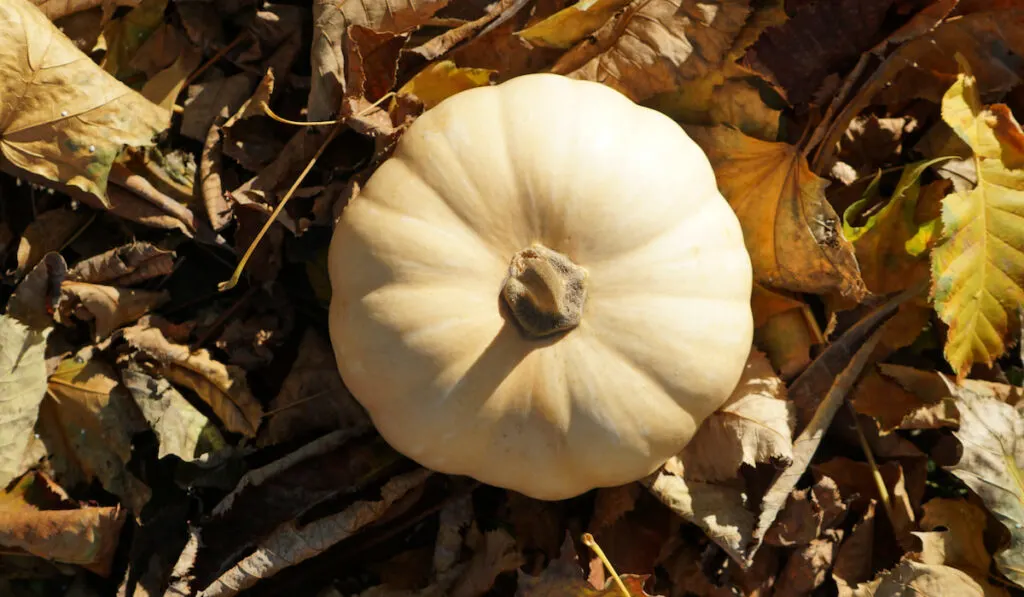There are a variety of pumpkins across the world ranging in colors, sizes, shapes, and patterns. These festive squashes are used for anything from decoration to delicious meals!
White pumpkins are one of those variations in color. Below is a list of 9 white pumpkin varieties that are sure to excite you for the holidays!
When looking to eat a white pumpkin it is important to find trustworthy recipes to prepare your dishes. Be sure to clean and wash pumpkins to ensure safe consumption.
| White pumpkin variety | Is it edible? | Used for |
| ‘Casper’ | Yes | Decoration, baking |
| ‘Silver Moon’ | Yes | Decoration, seeds |
| ‘Cotton Candy’ | Yes | Decoration, baking |
| ‘Baby Boo’ | Yes | Decoration, cooking |
| ‘Super Moon’ | Yes | Decoration, cooking |
| ‘Crystal Star’ | Yes | Decoration, carving, cooking |
| ‘White Connecticut Field’ | Yes | Decoration, seeds, cooking |
| ‘SnowBall’ | Yes | Decoration, cooking |
| ‘Hooligan’ | Yes | Ornamental, seeds |
Table of Contents
‘Casper’

The ‘Casper’ pumpkin originated in Central America. Due to its slow rise in popularity, there isn’t a lot of information about this pumpkin’s history. Originally created in the 1980s, this pumpkin has been widespread across the world and is commonly found in the United States today.
This pumpkin may weigh between 10 and 16 pounds with bright white skin.
The ‘Casper’ pumpkin is commonly used for decoration during the fall months. This pumpkin can also be used in the process of pumpkin pie. It grows to around 4-6 inches wide overall and is edible.
‘Silver Moon’
The ‘Silver Moon’ pumpkin originated in Australia and is found as a large indented flat sphere. The inside of this pumpkin is a bright orange/yellowish color that in some cases may resemble a cantaloupe.
‘Silver Moon’ is named for its bright white color and mysterious inside coloring and is used commonly for its seeds and fall decorations.
This pumpkin weighs between 11 to 16 pounds and can grow up to 9 inches wide. This pumpkin is edible for consumption.
‘Cotton Candy’
‘Cotton Candy’ pumpkin originated in Ohio. This pumpkin is a bright glossy white with sweet-flavored skin and insides. Weighing around 5-12 pounds, these pumpkins are perfect for the making of desserts.
It is known that these pumpkins may have a milky, sweet taste that is similar to that of cotton candy, hence their name. The ‘Cotton Candy’ pumpkin is overall edible and can be used for both cooking purposes as well as decoration.
‘Baby Boo’

The ‘Baby Boo’ pumpkin originated in Pennsylvania in the 1990s. These pumpkins were originally produced by a man named John Jaunsem from acorn squash. This pumpkin visually appears with bright white flesh. ‘Baby Boo’ commonly weighs around 1-2 pounds and can be 2 inches tall.
These pumpkins are often used for fall seasons of decoration, small carvings, and in some cases in cooking. This pumpkin is named for its small size and popularity among fun fall decor. These pumpkins are edible for both cooking and baking.
‘Super Moon’
The ‘Super Moon’ pumpkin first originated in Central Asia among many other white pumpkin breeds. This pumpkin is large and round, making it perfect for carving, painting, and decoration! ‘Super Moon can weigh up to 23-36 pounds and be as wide as 7 inches.
The ‘Super Moon’ pumpkin is perfect for eating. Their high seed count and soft exterior make them an ideal variety for cooking, baking, and carving!
Be sure to use caution when cooking and consuming a pumpkin, make sure to clean it and cook it through to avoid consumption of harmful bacteria!
‘Crystal Star’
The ‘Crystal Star’ pumpkin first originated in Central Asia. Known for its bright white color, this pumpkin is surely named for its crystal white and shining skin that makes it one of the best pumpkin strains for decoration.
These round pumpkins have the ability to grow up to 27-36 pounds and maybe 11 inches wide.
‘Crystal Star’ is commonly used for its decoration potential. Due to its large round surface, it is an ideal shape and size for pumpkin carving. It may also be used for painting, baking, and the production of seeds.
‘White Connecticut Field’

‘White Connecticut Field’ first originated in Vermont by a man named John Howland in 1870. This pumpkin is the result of growing seeds of unknown origin, one of which turned out to be white. This pumpkin is described as being soft-shelled with a dull white coloring.
The ‘White Connecticut Field’ pumpkin on average weighs around 10-20 pounds and can be 8-10 inches wide.
These pumpkins are edible and may be used for anything from eating to seed production to carving, to even plain decoration for the holidays.
‘Snowball’

‘Snowball’ pumpkins are a lesser snow-white pumpkin breed but are nonetheless beautiful. Like the name, this pumpkin is commonly a bright white color such as that resembling snow. This pumpkin is flat and round.
In addition, these pumpkins are edible.
The ‘Snowball’ pumpkin is small, like holding a snowball, and can be used for decoration during fall months, and in some cases, baking. This pumpkin is commonly 1-2 pounds.
‘Snowball’ has been described as tasting like a normal pumpkin with sweet bites and crunchy seeds.
If you are looking to prepare this pumpkin in any dish, be wary of cooking and washing the fruit before consuming it to ensure safety.
‘Hooligan’
The ‘Hooligan’ pumpkin first originated in Central Asia, a hybrid between the miniature pumpkin and the ‘Yellow Page’ pumpkin. This leads to a pumpkin that is not purely white, but one with spots, color, and patterns to add to its overall uniqueness.
The ‘Hooligan’ pumpkin on average grows up to 2” inches tall, weighing around 2-3 pounds. This pumpkin is commonly used for decoration and in some cases for baked snacks.
This small yet gorgeous squash is used for its ornamental design and in some cases for its seeds inside.

Difference Between Yellow and White Pumpkins
Yellow and white pumpkins have similarities and differences that make them unique and may make all the difference between taste and texture.
The yellow pumpkin originates from France. They commonly weigh between 40-50 pounds depending on the growth environment.
The white pumpkin originated in Central America and may weigh 12 and 15 pounds, again depending on their growing environment.
The main difference between white and yellow pumpkins is found within the skin.
White pumpkins may be prone to higher rates of mold more quickly, and blemishes on the skin. Yellow pumpkins have a smoother surface and are known to rot at a less frequent pace.
Besides the difference in these pumpkin’s skin, both white and yellow pumpkins taste identical. The true difference is in the coloring of the skin.
How to clean a pumpkin before consumption
Cleaning one’s food, especially produce, is important to removing any bugs and harmful bacteria that could be growing unseen.
One easy way to make sure your pumpkin is clean is to run it under warm water to loosen any and all dirt. Using a mild dish detergent will help remove any blemishes and mold areas, while a 3:1 water and vinegar solution will lead to the dismissal of any lingering bacterial growth.
Sources
- https://www.epicgardening.com/white-pumpkins
- https://wgno.com/news/business/whats-the-deal-with-white-pumpkins
- https://www.homefortheharvest.com/yellow
- https://specialtyproduce.com/produce/Pumpkins_Lumina_White
- https://www.ufseeds.com/product/casper-pumpkin-seeds/PUCAS
- https://www.neseed.com/shop/vegetable-seeds/pumpkin/flat-stacking-type/silver-moon-f1-hybrid
- https://www.cooksinfo.com/cotton-candy-pumpkins
- https://www.seedneeds.com/products/baby-boo-pumpkin
- https://hosstools.com/product/hooligan-pumpkin
- https://www.johnnyseeds.com/vegetables/pumpkins/specialty-pumpkins/snowball-f1-pumpkin-seed
- https://gardengrowguide.com/white-ghost-pumpkins-care-types-and-growing-tips
- https://www.ruppseeds.com/vegetables/products/pumpkins/white/crystal-star
- https://www.jungseed.com/product
- https://hosstools.com/product/super-moon-pumpkin
